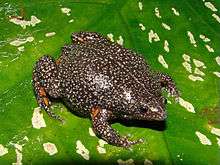Elachistocleis pearsei
| Elachistocleis pearsei | |
|---|---|
 | |
| Scientific classification | |
| Kingdom: | Animalia |
| Phylum: | Chordata |
| Class: | Amphibia |
| Order: | Anura |
| Family: | Microhylidae |
| Genus: | Elachistocleis |
| Species: | E. pearsei |
| Binomial name | |
| Elachistocleis pearsei (Ruthven, 1914) | |
| Synonyms | |
|
Relictivomer pearsei (Ruthven, 1914) | |
Elachistocleis pearsei (common name: Colombian plump prog) is a species of frog in the Microhylidae family. It is found in the Caribbean drainage of Colombia and Panama and in northwest Venezuela.[2][3]
Elachistocleis pearsei was until recently considered to form monotypic genus Relictivomer, but in molecular phylogeny Elachistocleis pearsei is nested within other Elachistocleis, leading to resurrection of name Elachistocleis pearsei.[4][5]
Biology of Elachistocleis pearsei is poorly known. It is considered to be a lowland species inhabiting forests, possibly also savanna. Breeding takes place in temporary pools. It is probably impacted by habitat loss.[1]
References
- 1 2 John Lynch; Enrique La Marca (2004). "Relictivomer pearsei". IUCN Red List of Threatened Species. Version 2013.2. International Union for Conservation of Nature. Retrieved 29 November 2013.
- ↑ Frost, Darrel R. (2014). "Elachistocleis pearsei (Ruthven, 1914)". Amphibian Species of the World: an Online Reference. Version 6.0. American Museum of Natural History. Retrieved 22 March 2014.
- ↑ AmphibiaWeb: Information on amphibian biology and conservation. [web application]. 2013. Berkeley, California: Elachistocleis pearsei. AmphibiaWeb, available at http://amphibiaweb.org/. (Accessed: 29 November 2013).
- ↑ De Sá, R. O.; Streicher, J. W.; Sekonyela, R.; Forlani, M. C.; Loader, S. P.; Greenbaum, E.; Richards, S.; Haddad, C. L. F. B. (2012). "Molecular phylogeny of microhylid frogs (Anura: Microhylidae) with emphasis on relationships among New World genera". BMC Evolutionary Biology. 12: 241. PMC 3561245
 . PMID 23228209. doi:10.1186/1471-2148-12-241.
. PMID 23228209. doi:10.1186/1471-2148-12-241. - ↑ Frost, Darrel R. (2014). "Elachistocleis Parker, 1927". Amphibian Species of the World: an Online Reference. Version 6.0. American Museum of Natural History. Archived from the original on 22 March 2014. Retrieved 22 March 2014.
| Wikimedia Commons has media related to Relictivomer pearsei. |
This article is issued from
Wikipedia.
The text is licensed under Creative Commons - Attribution - Sharealike.
Additional terms may apply for the media files.
